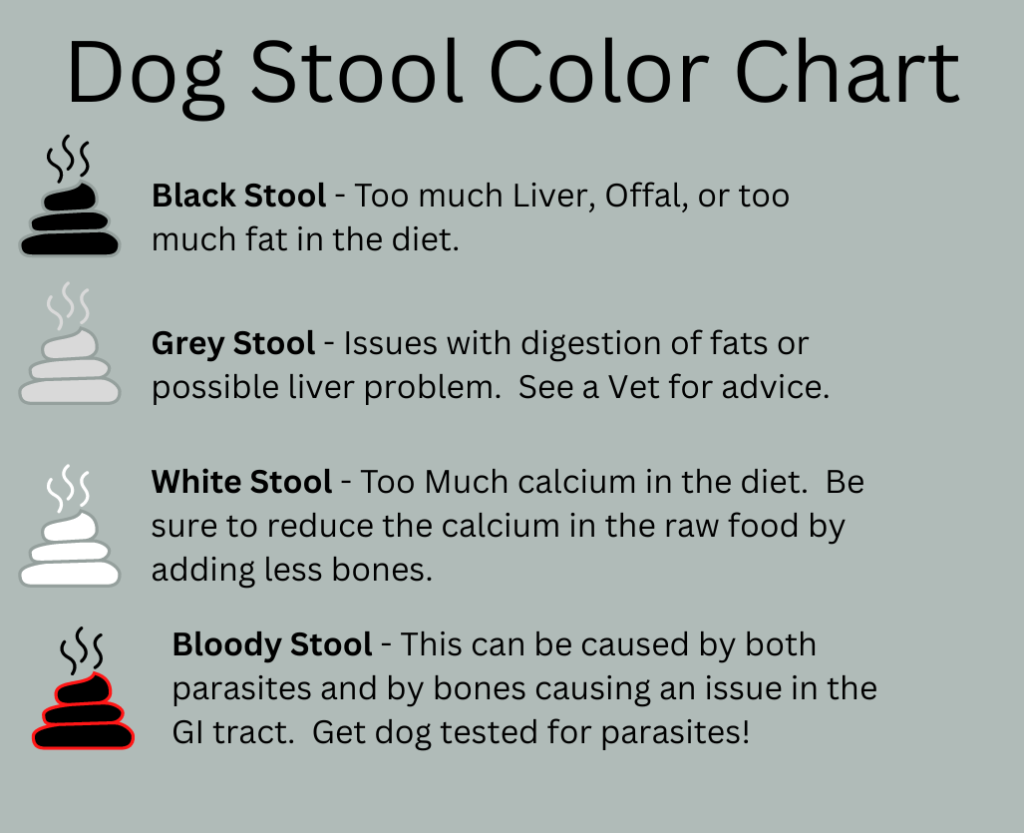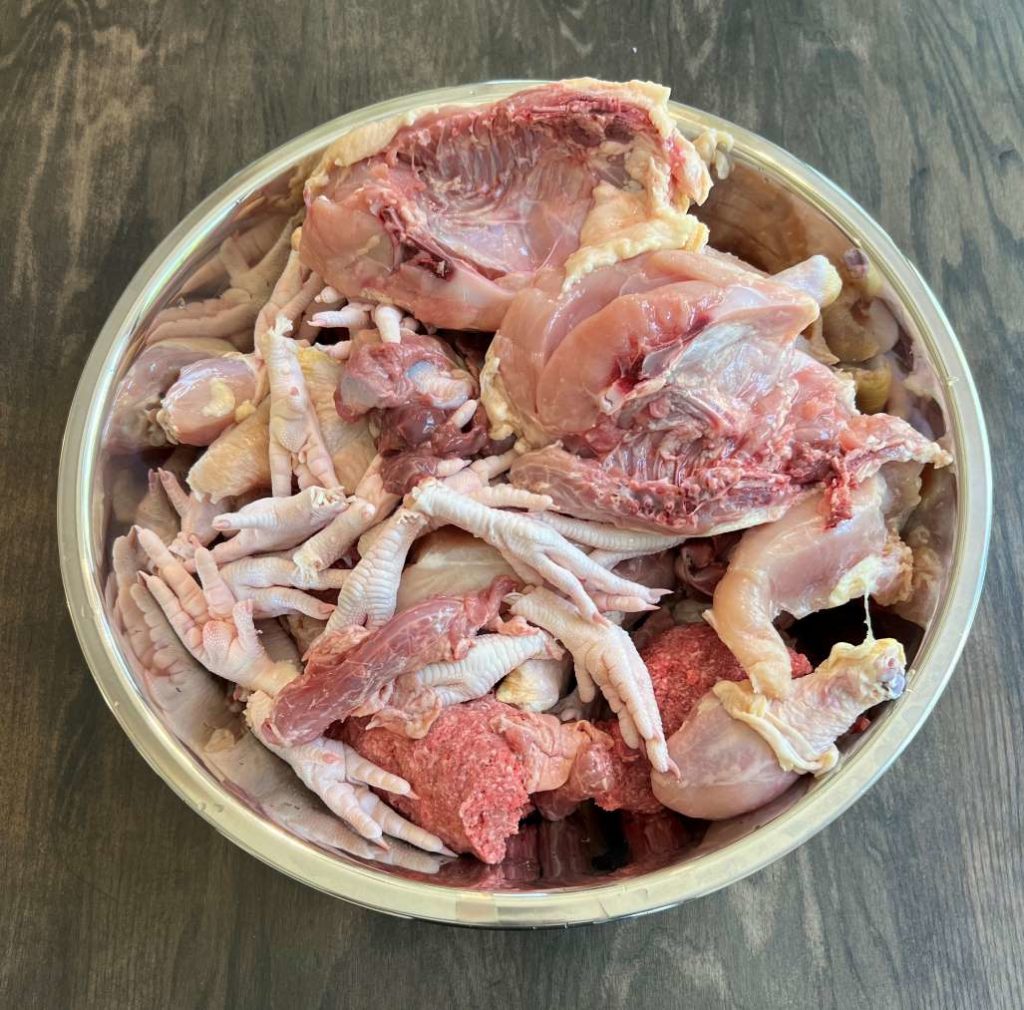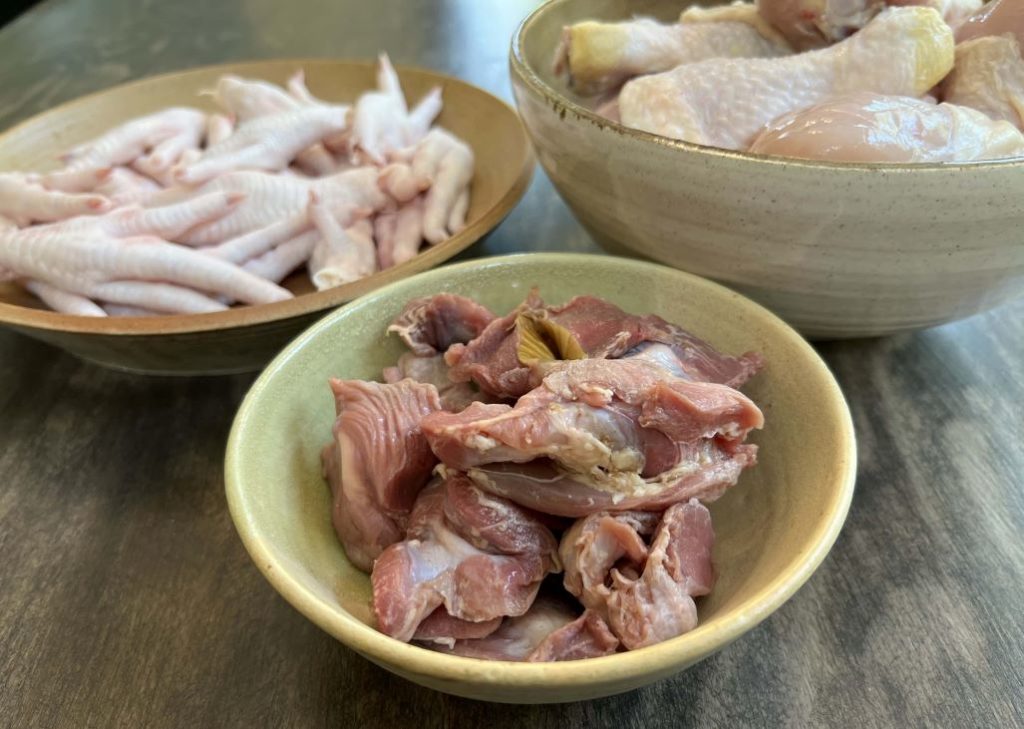Raw Fed Dog Poop Guide
This topic may seem gross to talk about but it’s pretty important. The raw fed dog poop has lots of valuable information contained within. The color, shape, firmness and odor can each tell you something about your dog’s diet. You dogs stool is a good guide to see if your raw feeding recipe is optimal. Here is everything you need to know about raw fed dog poop.
What is considered a normal raw fed dog poop?
A normal stool for a raw fed dog should pass from the dog relatively easy. It should be soft but hard enough that it has defined shape. The dog should not struggle when it is passing its stool. A normal stool should also be hard enough that it helps to express the dog’s anal glands regularly.
If the stool Is too soft, the anal gland can become clogged. Eventually it either releases itself somewhere you do not want, or you have to have a professional clean the glands. Another sign that the anal gland needs to be expressed is that the dog will rub its butt on objects or drag its hind area on the floor. It can be painful to the dog. So a normal raw fed dog stool should be firm enough to express the glands.
It is also common to see pieces of undigested bone and some vegetables in the stool. Some of the bones may pass through the dog without being digested. I have seen this more when feeding whole chicken backs. If the raw dog food is ground up, its less common to see bone. The raw dog food poop color is often dark brown to black because of the protein in the raw meat. Its also normal to see a white dog poop if the dog is raw fed. After a day or two being outside in the elements, the stool can turn to a white or grey color and it turns to dust. This type of stool usually has a higher level of calcium in it.
How often do dogs poop on raw diet?
This will vary greatly from one dog to the next. All three of my raw fed dogs pooped about 1 time per day. The raw diet bowel movements seem to be much smaller then commercial kibble. I think its due to the fact that the BARF diet does not have an fillers or added fiber. I see raw fed dog poop on a daily basis with my dog.

Raw Fed Dog Poop Guide:
- Dark Black and Greasy – From my experience, this only occurs when you give too much organ meat, specifically liver. Too much liver will make a dark, loose stool that is a bit on the greasy side. Its best to make sure they liver content of the raw food is 10%. This also can indicate that your dog has an issue with its pancreas.
- Runny Stools – These are not very common if you follow the Barf Diet. With the amount of bone in the dog’s diet being 10% its unlikely to have a runny stool caused by the food. Common things that can cause a runny stool are eating other animals’ feces, eating wild mushrooms, or any other number of toxic items. It is a greater concern after a few days of repeat loose stools. This poses a risk of dehydration for the dog. Monitor the dog, push fluids and bring to the vet if this continues for more then a few days.
- Grey – Stools that are grey in color can be caused by issues with a few of the organs. Both the liver and the pancreas can have issues resulting in a grey colored stool. Please consult a veterinarian if your dog has repeated grey stools.
- Very hard – The main thing that causes a hard stool in raw fed dogs is the amount of bone in their diet. The calcium in the bone makes the stool firm. If your dog is straining, check how much bone is being put into the meals. For adult dogs the raw meaty bones should consists of 10% of their diet. The number for puppies is closer to 17%. If you go too high, the stool becomes to hard for the dog to pass and it could impact inside of the dog.
- Blood in the stool – Dogs can have a few issues that cause blood in their stools. If larger bones are given to the dog, its possible that a sharp bone could cause some intestinal damage. The more likely culprit for blood in the stools is a parasite. Feeding raw can introduce parasites to the dog’s digestive tract. I have heard of dogs getting parasites from raw fed diet. I have never experienced that with my 7+ years of raw feeding.
What to expect when switching dog to raw
Its often recommend to use a 7-day transition period. In the first few days you slowly increase how much of the new food the dog is given. Over the course of 7 days, slowly increase the raw food while decreasing the kibble per meal. By day 7 the dog should be entirely on the new raw food. This transition allows the dogs digestive tract to adjust slowly. If you choose to switch the dog over immediately, be prepared for some loose stools. Without the 7 day adjustment, the dogs gut bacteria does not have time to adjust. Its important to note that the
Frequently asked questions about raw fed dog poop –
If you have ever owned a dog, I am sure you have experienced at least one of the problematic stools. Here is a list of commonly asked questions and what to do. Please seek advice from your veterinarian if your dog has consistently not normal stool for any prolonged duration.
1.What to feed a raw fed dog with diarrhea?
The most important thing to do when your dog has loose stools is to keep it hydrated. Dehydration can happen very quickly depending on environmental conditions. Dogs can be given baby Pedialyte (make sure it has no xylitol in it). Its best to get the all-natural kind that doesn’t have many additives like color.
The dog should fast for a day, then be given a bland diet. My preferred method is boiled chicken breast and a little bit of rice. This an help the dog stabilize its digestive tract. If you can not get it under control after 3 or 4 days, its best to go see a veterinarian. The dog will most likely be given a GI antibiotic to combat their issue. The dog should also be tested for parasites so don’t forget to take a stool sample with you.
2. What to do if the dog has black greasy stools?
Raw fed dog poop is often dark brown to sometimes black. If it is very black and greasy, start out by confirming the amount of liver and tripe the dog is being fed. If you are over 10% liver, bring that number down to 10%. You can decrease the liver by 1% every few meals to see if the stool returns to normal. If it does not change after adjusting the food, you should seek advice from a veterinarian. This could be indicating that the dog cannot break down fat. This condition is often pancreatitis. If you are feeding your dog anything that is high in fat, stop. This could be ice cream, butter or anything else that might seem harmless. Dogs do no digest fat the same as humans and this could be the culprit.
3. What to do if your dog has grey stools?
Raw fed dog poop should not typically be grey in color. For this type of stool, I would advise you to seek help from your veterinarian. If the dog repeatedly has grey tools, the vet will surely want a sample and a visit with your dog. I personally have not had a dog get this issue while raw feeding
4. What to do if your dog is struggling to pass stool?
The most common cause for this with a raw fed dog is the amount or raw meaty bones being given. I have this post – Barf Diet For Dogs, that shows the ratios to start out with when raw feeding. The amount of bone given might need to be adjusted down a bit.
A more immediate solution to this problem Is to give the dog some pumpkin. It usually be solved quickly with some canned pumpkin puree. Do not get the kind with any spices in it, you just want pure pumpkin. Try adding a few tablespoons at each meal. You should see results quickly. I experienced this with my older dog, it seemed she was having issues digesting the raw bone. I ended up using the grinder method for her once I noticed she had an issue. Within a few days she was back to passing a normal stool.
5. What to do if the dog has blood in its stool?
If your dog is having a bloody stool, its best to get it evaluated by the vet. If this condition persists it could be a parasite or some bacterial infection the dog is experiencing. Remember to save a stool sample for testing before taking the dog to the vet. There are quiet a few pathogens that can cause this. Hookworm, roundworm, tapeworm, Giardia are all parasites that can cause blood in their stool. Giardia is very contagious especially in social environments for dogs. Most of these ailments require medicine to resolve. It is best to have your veterinarian identify the root cause through testing.
6. Why is my raw fed dogs poop white?
This can be caused by far too much calcium in the dogs meals. It is expected that raw fed dog poop will be white on some occasions. If its white with every digestive movement the calcium might be too high. Recheck how much calcium is being given to the dog. Don’t forget to check the vitamins if any are given. They could also contain calcium. Raw fed dogs will sometimes have white stool due to high calcium in the last meal. This really is not a concern unless the dog is struggling to pass its stool.
7. Does raw food make dogs poop hard?
Dogs should not have super hard stools when being fed raw. If it appears that your dog is struggling when pooping, it has been suggested that some pumpkin be added to the diet to relieve the constipation. It is also advisable to recheck the calcium amounts in the food you are feeding the dog if it struggles to go.
8. how does raw food affect dog poop?
Well to start, dogs will poop out smaller amounts when raw fed. There is less waste with raw feeding because more of the ingredients used are digestible by the dog. Commercial kibble has a lot of fillers that are not needed by the dog.
Secondly the color will vary much more then with a kibble dog. When fed kibble the poop is often stinky and the same color brown every day. With a raw fed diet, it can be black a few days then white, then brown. The color depends on what type of animal protein and bone are being given to the dog.
The last difference is that raw fed dogs poop is generally not as odorous as ones that are fed commercial kibble. I am not sure if this is due to different guy biomes in raw fed dogs. It could also have to do with the fillers that are in kibble.
Related Topics:







